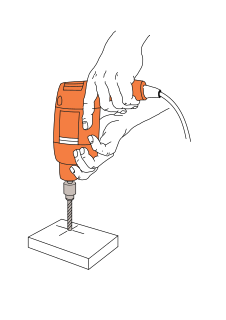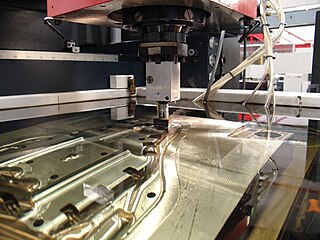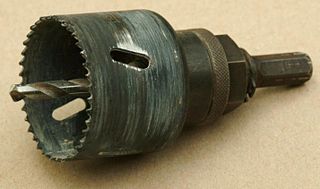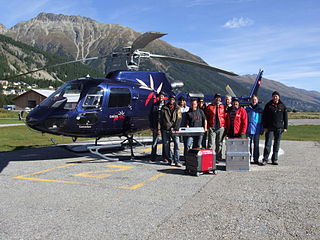 W
WA borehole is a narrow shaft bored in the ground, either vertically or horizontally. A borehole may be constructed for many different purposes, including the extraction of water, other liquids or gases, as part of a geotechnical investigation, environmental site assessment, mineral exploration, temperature measurement, as a pilot hole for installing piers or underground utilities, for geothermal installations, or for underground storage of unwanted substances, e.g. in carbon capture and storage.
 W
WBoring is drilling a hole, tunnel, or well in the earth.
 W
WIn machining, boring is the process of enlarging a hole that has already been drilled by means of a single-point cutting tool, such as in boring a gun barrel or an engine cylinder. Boring is used to achieve greater accuracy of the diameter of a hole, and can be used to cut a tapered hole. Boring can be viewed as the internal-diameter counterpart to turning, which cuts external diameters.
 W
WA brace is a hand tool used with a bit to drill holes, usually in wood. Pressure is applied to the top and the tool is rotated with a U-shaped grip. Bits used come in a variety of types but the more commonly used Ridgeway- and Irwin- pattern bits also rely on a snail point, which is a tapered screw point shaped the same as a wood screw thread, which helps to pull the bit into the wood as the user turns the brace handle and applies pressure
 W
WA drill or drilling machine is a tool primarily used for making round holes or driving fasteners. It is fitted with a bit, either a drill or driver, depending on application, secured by a chuck. Some powered drills also include a hammer function.
 W
WDrill bits are cutting tools used to remove material to create holes, almost always of circular cross-section. Drill bits come in many sizes and shapes and can create different kinds of holes in many different materials. In order to create holes drill bits are usually attached to a drill, which powers them to cut through the workpiece, typically by rotation. The drill will grasp the upper end of a bit called the shank in the chuck.
 W
WAn electric drill is a drill which is driven by an electric motor. The invention of the electric drill is credited to Arthur James Arnot and William Blanch Brain of Melbourne, Australia who patented the electric drill in 1889. In 1895, the first portable handheld drill was created by brothers Wilhelm & Carl Fein of Stuttgart, Germany. In 1917 the first trigger-switch, pistol-grip portable drill was patented by Black & Decker.
 W
WElectrical discharge machining (EDM), also known as spark machining, spark eroding, die sinking, wire burning or wire erosion, is a metal fabrication process whereby a desired shape is obtained by using electrical discharges (sparks). Material is removed from the work piece by a series of rapidly recurring current discharges between two electrodes, separated by a dielectric liquid and subject to an electric voltage. One of the electrodes is called the tool-electrode, or simply the tool or electrode, while the other is called the workpiece-electrode, or work piece. The process depends upon the tool and work piece not making physical contact.
 W
WFriction drilling is a method of making holes in metal in which the material is pushed out of the way with the aid of heat from friction. The process is also called thermal drilling, flow drilling, form drilling, or friction stir drilling.
 W
WA gimlet is a hand tool for drilling small holes, mainly in wood, without splitting. It was defined in Joseph Gwilt's Architecture (1859) as "a piece of steel of a semi-cylindrical form, hollow on one side, having a cross handle at one end and a worm or screw at the other".
 W
WGun drills are straight fluted drills which allow cutting fluid to be injected through the drill's hollow body to the cutting face. They are used for deep drilling—a depth-to-diameter ratio of 300:1 or more is possible. Gun barrels are the obvious example; hence the name. Other uses include moldmaking, diemaking, and the manufacture of combustion engine parts such as crankcase, cylinder head, and woodwind musical instruments, such as uilleann pipes, as gun drills can drill long straight holes in metal, wood, and some plastics. The coolant provides lubrication and cooling to the cutting edges and removes the swarf or chips from the hole. Modern gun drills use carbide tips to prolong life and reduce total cost when compared with steel tips. Speed of drilling depends on the material being drilled, rotational speed, and the drill diameter; a high speed drill can cut a hole in P20 steel at 30 inches per minute.
 W
WA hole punch, also known as hole puncher, or paper puncher, is an office tool that is used to create holes in sheets of paper, often for the purpose of collecting the sheets in a binder or folder. The term can also refer to tools of different construction from one designed for paper, such as a those used for leather goods, for cloth, for thin plastic sheeting, and for variations of sheet metal, such as aluminum siding or metal air ducts.
 W
WA hole saw, also known as a hole cutter, is a saw blade of annular (ring) shape, whose annular kerf creates a hole in the workpiece without having to cut up the core material. It is used in a drill. Hole saws typically have a pilot drill bit (arbor) at their center to keep the saw teeth from walking. The fact that a hole saw creates the hole without needing to cut up the core often makes it preferable to twist drills or spade drills for relatively large holes. The same hole can be made faster and using less power.
 W
WIceMole is an autonomous ice research probe, incorporating a new type of ice-melting tip for the exploration of polar regions, glaciers, ice sheets, and extraterrestrial regions, developed by a team from the FH Aachen, a Fachhochschule in Aachen, Germany. The advantage over previous probes is that the IceMole can change its direction and can be recovered after being used. A driving ice screw allows the probe to drill through soil layers and other contaminations in the ice.
 W
WA leather punch is a hole punch specifically for making holes in leather. The working tip of the punch is a hollow steel cylinder with a sharp circular knife-like edge. The leather piece is placed on a hard surface, which may be a part of the tool set, and the punch is forced through it, cutting out a small circular piece which is discarded. The punch may be a simple metal tool struck with a hammer; or several such punches may be mounted on a rotary turret on a pliers-like tool with an anvil, with the desired size selected by rotating the turret. Hole diameters typically range from about 1mm to 6mm. They are typically used for making holes for buckles, eyelets, and rivets in shoes, belts, bridles, etc.
 W
WBelow is a comprehensive drill and tap size chart for all drills and taps, imperial and metric, up to 36.5 millimetres (1.44 in) in diameter.
 W
WA pilot hole is a small hole drilled into a piece of construction material. Its purpose is a) to guide a larger drill to the appropriate location and ease the job of the larger drill, b) to allow for the insertion of another hole-making tool, such as a knockout punch, that will produce the final-sized hole, or c) to locate, guide, and provide clearance for a self-threading screw in wood or plastic to prevent damaging the material or breaking the screw.
 W
WA trephine is a surgical instrument with a cylindrical blade. It can be of one of several dimensions and designs depending on what it is meant to be used for. They may be specially designed for obtaining a cylindrically shaped core of bone that can be used for tests and bone studies, cutting holes in bones or for cutting out a round piece of the cornea for eye surgery.